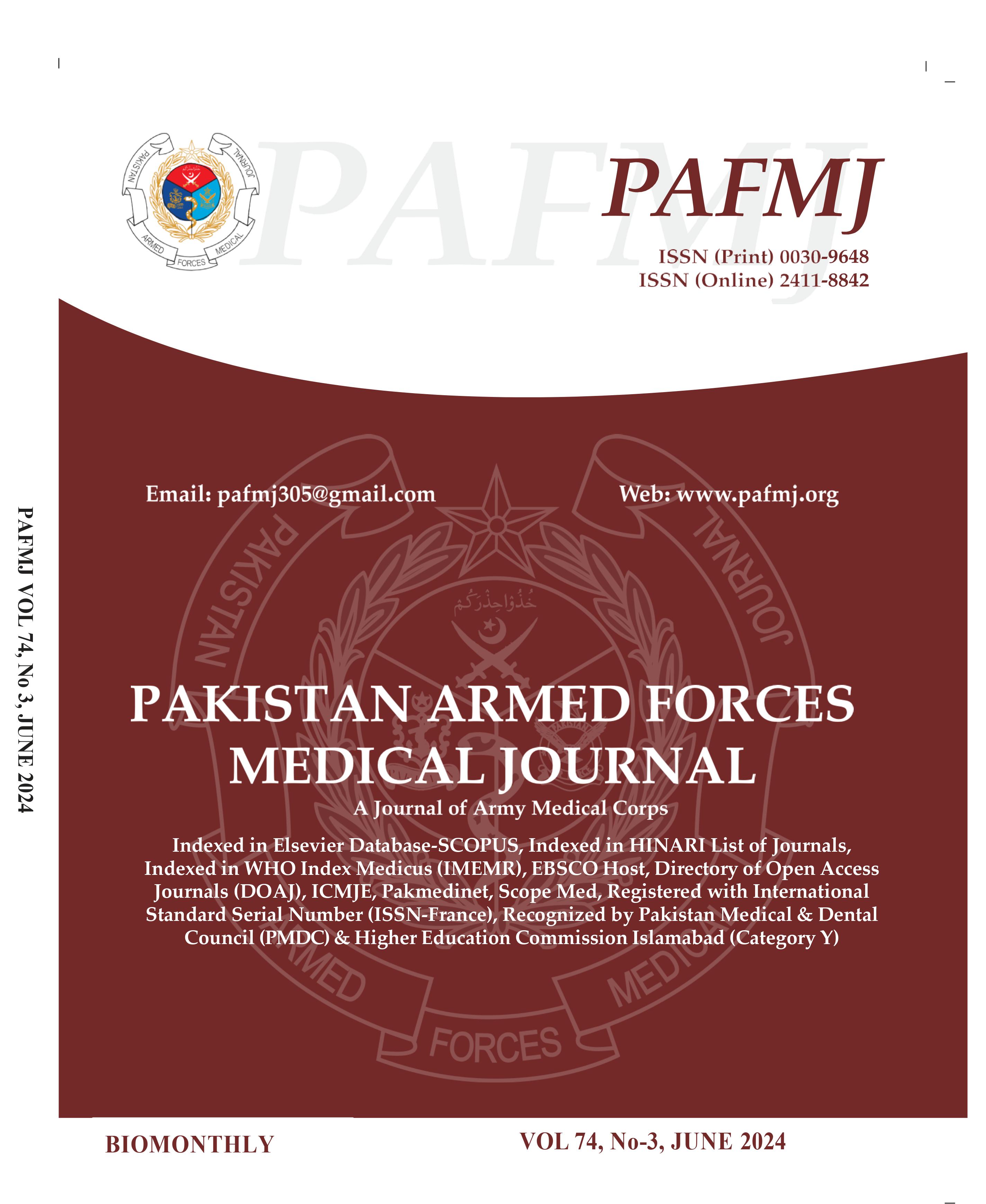Post Central Line Insertion Complication Rate in Tertiary Care Hospital Comparison between Different Sites
DOI:
https://doi.org/10.51253/pafmj.v74i3.10306Keywords:
Central venous catheterization, Deep vein thrombosis, Pneumothorax.Abstract
Objective: To evaluate the post-central line insertion complication rate at various central venous catheterization sites in a tertiary care teaching hospital.
Study Design: Prospective comparative study.
Place and Duration of Study: Pak Emirates Military Hospital, Rawalpindi Pakistan, from Aug 2022 to Jan 2023.
Methodology: Data from 126 patients who had central venous line insertion was collected, and it was assessed for early and delayed complications related to central venous line insertion with respect to site.
Results: The mean age of patients undergoing central venous line insertion was 55.74±12. A total of 38 mechanical complications over 54 years were documented in this study. The rate of pneumothoraxes with internal jugular insertion was 9(7.14%), although this was not statistically significant. Total arterial injuries were 21(0.16%), 10(0.07%) in internal jugular, and 11(0.08%) in femoral. The rate at which one or more delayed complications occurred following a given CVC placement was 8(6.4%). By body part, 31(24.6%) of interjugular central venous catheters and 38(30.12%) of femoral central venous catheters had at least one delayed problem. The total catheter-related blood stream infection was higher with central lines inserted in the femoral vein. No complications were reported in 37 patients.
Conclusion: Both internal jugular and femoral sites cause more delayed complications than mechanical complications. At the femoral site, the catheter-related bloodstream infection rate was higher.
Downloads
References
Kolikof J, Peterson K, Baker AM. Central Venous Catheter. In: StatPearls. Treasure Island (FL): StatPearls Publishing; 2024.
Badia-Cebada L, Peñafiel J, Saliba P, Andrés M, Càmara J, Domenech D, et al; VINCat programme (Infection Control Catalan Programme). Trends in the epidemiology of catheter-related bloodstream infections; towards a paradigm shift, Spain, 2007 to 2019. Euro Surveill 2022; 27(19): 2100610.
https://doi.org/10.2807/1560-7917.ES.2022.27.19.2100610
Jamshidi R. Central venous catheters: Indications, techniques, and complications. Semin Pediatr Surg 2019; 28(1): 26-32.
https://doi.org/10.1053/j.sempedsurg.2019.01.005
Aufricht G, Hoang J, Iglesias J, Latiolais H, Sheffield H, Trejo C, et al. Analysis of central venous catheter utilization at a quaternary care hospital. Proc Bayl Univ Med Cent 2019; 32(1): 1-4. https://doi.org/10.1080/08998280.2018.1542651
Morzaria P, Carle C. Should central venous catheters be routinely replaced in adults? Br J Hosp Med 2021; 82(7): 1-2.
https://doi.org/10.12968/hmed.2020.0711
Bell J, Goyal M, Long S, Kumar A, Friedrich J, Garfinkel J, et al. Anatomic Site-Specific Complication Rates for Central Venous Catheter Insertions. J Intensive Care Med 2020; 35(9): 869-874. https://doi.org/10.1177/0885066618795126
Fahy B, Sockrider M. Central Venous Catheter. Am J Respir Crit Care Med 2019; 199(11): P21-P22.
https://doi.org/10.1164/rccm.19911P21
Lenz H, Myre K, Draegni T, Dorph E. A Five-Year Data Report of Long-Term Central Venous Catheters Focusing on Early Complications. Anesthesiol Res Pract 2019; 2019: 6769506.
https://doi.org/10.1155/2019/6769506
Sun Y, Bao Z, Guo Y, Yuan X. Positive effect of care bundles on patients with central venous catheter insertions at a tertiary hospital in Beijing, China. J Int Med Res 2020; 48(7): 300060520942113.
https://doi.org/10.1177/0300060520942113
Björkander M, Bentzer P, Schött U, Broman ME, Kander T. Mechanical complications of central venous catheter insertions: A retrospective multicenter study of incidence and risks. Acta Anaesthesiol Scand 2019; 63(1): 61-68.
https://doi.org/10.1111/aas.13214
Imataki O, Shimatani M, Ohue Y, Uemura M. Effect of ultrasound-guided central venous catheter insertion on the incidence of catheter-related bloodstream infections and mechanical complications. BMC Infect Dis 2019; 19(1): 857.
https://doi.org/10.1186/s12879-019-4487-0
Brescia F, Pittiruti M, Ostroff M, Biasucci DG. Rapid Femoral Vein Assessment (RaFeVA): A systematic protocol for ultrasound evaluation of the veins of the lower limb, so to optimize the insertion of femorally inserted central catheters. J Vasc Access 2021; 22(6): 863-872.
https://doi.org/10.1177/1129729820965063
Hamada SR, Fromentin M, Ronot M, Gauss T, Harrois A, Duranteau J, et al. Femoral arterial and central venous catheters in the trauma resuscitation room. Injury 2018; 49(5): 927-932.
https://doi.org/10.1016/j.injury.2018.03.026
Buetti N, Mimoz O, Mermel L, Ruckly S, Mongardon N, Dupuis C, et al. Ultrasound Guidance and Risk for Central Venous Catheter-Related Infections in the Intensive Care Unit: A Post Hoc Analysis of Individual Data of 3 Multicenter Randomized Trials. Clin Infect Dis. 2021; 73(5): e1054-e1061.
https://doi.org/10.1093/cid/ciaa1817
Timsit JF, Baleine J, Bernard L, Calvino-Gunther S, Darmon M, Dellamonica J, et al. Expert consensus-based clinical practice guidelines management of intravascular catheters in the intensive care unit. Ann Intensive Care 2020; 10(1): 118.
https://doi.org/10.1186/s13613-020-00713-4
Tölle D, Hentrich M, Pelzer BW, Kremer P, Einhell S, Schulz S, et al. Impact of neutropenia on central venous catheter-related bloodstream infections in patients with hematological malignancies at the time of central venous catheter insertion: A matched-pair analysis. Infect Control Hosp Epidemiol 2019; 40(10): 1204-1206. https://doi.org/10.1017/ice.2019.224
Patel AR, Patel AR, Singh S, Singh S, Khawaja I. Central Line Catheters and Associated Complications: A Review. Cureus 2019; 11(5): e4717. https://doi.org/10.7759/cureus.4717
Björkander M, Bentzer P, Schött U, Broman ME, Kander T. Mechanical complications of central venous catheter insertions: A retrospective multicenter study of incidence and risks. Acta Anaesthesiol Scand 2019; 63(1): 61-68.
Downloads
Published
Issue
Section
License
Copyright (c) 2024 Muhammad Ahsan Mahmood, Salman Saleem, Sadaf Nawaz, Ali Ghawas, Ahsan Amer, Ahmed Amer

This work is licensed under a Creative Commons Attribution-NonCommercial 4.0 International License.















